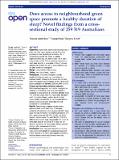Files in this item
Does access to neighbourhood green space promote a healthy duration of sleep? Novel findings from a cross-sectional study of 259 319 Australians
Item metadata
| dc.contributor.author | Astell-Burt, Thomas | |
| dc.contributor.author | Feng, Xiaoqi | |
| dc.contributor.author | Kolt, Gregory S. | |
| dc.date.accessioned | 2014-07-21T12:01:00Z | |
| dc.date.available | 2014-07-21T12:01:00Z | |
| dc.date.issued | 2013-08-13 | |
| dc.identifier | 134140710 | |
| dc.identifier | 38382e9c-3c02-49c3-b1c7-e3bebeb125a6 | |
| dc.identifier | 000330561300079 | |
| dc.identifier | 84885353924 | |
| dc.identifier.citation | Astell-Burt , T , Feng , X & Kolt , G S 2013 , ' Does access to neighbourhood green space promote a healthy duration of sleep? Novel findings from a cross-sectional study of 259 319 Australians ' , BMJ Open , vol. 3 , no. 8 , 003094 . https://doi.org/10.1136/bmjopen-2013-003094 | en |
| dc.identifier.issn | 2044-6055 | |
| dc.identifier.uri | https://hdl.handle.net/10023/5047 | |
| dc.description.abstract | Objectives: Experiments demonstrate that exposure to parks and other 'green spaces' promote favourable psychological and physiological outcomes. As a consequence, people who reside in greener neighbourhoods may also have a lower risk of short sleep duration (<6 h). This is potentially important as short sleep duration is a correlate of obesity, chronic disease and mortality, but so far this hypothesis has not been previously investigated. Design: Cross-sectional data analysis. Setting: New South Wales, Australia. Participants: This study investigated whether neighbourhood green space was associated with a healthier duration of sleep (to the nearest hour) among 259 319 Australians who completed the 45 and Up Study baseline questionnaire between 2006 and 2009 inclusive. Primary and secondary outcome measures: Multinomial logit regression was used to investigate the influence of an objective measure of green space on categories of sleep duration: 8 h (normal); between 9 and 10 h (mid-long sleep); over 10 h (long sleep); between 6 and 7 h (mid-short sleep); and less than 6 h (short sleep). Models were adjusted for psychological distress, physical activity and a range of demographic and socioeconomic characteristics. Results: People living in greener neighbourhoods reported a lower risk of short sleep. For example, compared with participants living in areas with 20% green space land-use, the relative risk ratios for participants with 80%+ green space was 0.86 (95% CI 0.81 to 0.92) for durations between 6 and 7 h, and 0.68 (95% CI 0.57 to 0.80) for less than 6 h sleep. Unexpectedly, the benefit of more green space for achieving 8 h of sleep was not explained by controls for psychological distress, physical activity or other socioeconomic factors. Conclusions: Green space planning policies may have wider public health benefits than previously recognised. Further research in the role of green spaces in promoting healthier sleep durations and patterns is warranted. | |
| dc.format.extent | 6 | |
| dc.format.extent | 597034 | |
| dc.language.iso | eng | |
| dc.relation.ispartof | BMJ Open | en |
| dc.subject | Public open space | en |
| dc.subject | Psychological distress | en |
| dc.subject | Screening scales | en |
| dc.subject | Social support | en |
| dc.subject | Mental-health | en |
| dc.subject | Population | en |
| dc.subject | Obesity | en |
| dc.subject | Noise | en |
| dc.subject | Environments | en |
| dc.subject | Metaanalysis | en |
| dc.subject | G Geography (General) | en |
| dc.subject | SDG 3 - Good Health and Well-being | en |
| dc.subject | SDG 15 - Life on Land | en |
| dc.subject.lcc | G1 | en |
| dc.title | Does access to neighbourhood green space promote a healthy duration of sleep? Novel findings from a cross-sectional study of 259 319 Australians | en |
| dc.type | Journal article | en |
| dc.contributor.institution | University of St Andrews. School of Geography and Geosciences | en |
| dc.contributor.institution | University of St Andrews. School of Geography & Sustainable Development | en |
| dc.identifier.doi | 10.1136/bmjopen-2013-003094 | |
| dc.description.status | Peer reviewed | en |
This item appears in the following Collection(s)
Items in the St Andrews Research Repository are protected by copyright, with all rights reserved, unless otherwise indicated.

